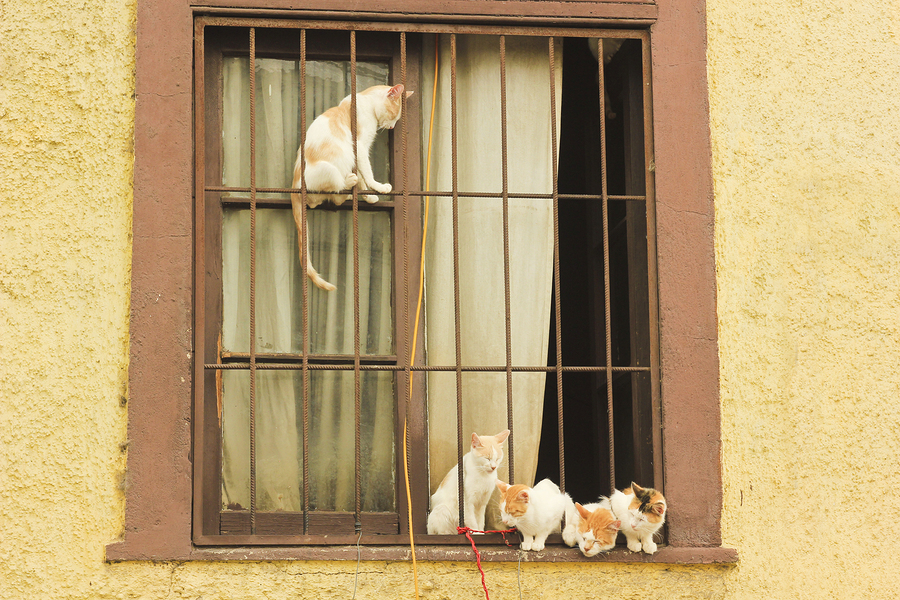This post may contain affiliate links. We are compensated for referring customers to our affiliate partners.
Let’s face it – who wants to have just one cat? Cats are awesome, especially when in an abundance! I will be the first to testament to the believe that “the more, the merrier” when it comes to our feline friends. However, as tempting as it may be to dash out the door and find a kitten to fall in love with, you should consider all of the factors and potential implications of doing so. Do your research! If you are considering caring for multiple cats, or are currently encountering problems with multiple cats, read further as we provide a cat food guide for feeding multiple cats in the same home.
Multiple Cats, Multiple Problems
When attempting to feed multiple cats, there are numerous problems and complications that can occur. First and foremost is the potential necessity of different diets. Different cats, and different species of cats, may have different nutritional needs. Diets can change based on a cat’s age, lifestyle, and health. This obviously requires you to feed each cat their own food, which brings us to the next problem. The “dominance factor” tends to come into play, as it does in any multi-cat scenario. Assertive cats may steal or guard food from cats that are shyer, going as far as bullying shy cats into leaving food in their bowl. These issues can be subtle and can easily go undetected by an owner. As you likely know by now, cats are grazers. Often times they do not finish their food in one sitting, instead eating in small amounts. Since this behavior is considered normal, it may be difficult to detect, diagnose, and resolve the fact that it is actually occurring as a result of another cat.
Where this truly becomes an issue is when dealing with medications or a cat food allergy. Sure, it is a problem if a dominant cat is bullying its way into more food. This becomes problem becomes a full-blown crisis when a cat consumes something that triggers a food allergy, or medication that was not meant for him.
The dominance problem can lead to health problems on both ends of the spectrum. Cats that are not consuming all of the food meant for them will potentially suffer from malnutrition, among other issues. Cats that are consuming food that is not meant for them face complications with obesity as a result of over-eating. Over half of pet cats in the U.S. are obese due to overeating and lack of exercise. Cats are dominant and competitive by nature, and will seek to assert control over an unmonitored eating situation.
Expanding on the “unmonitored” from above, it is worth noting the owner’s responsibilities, where lack of attention can lead to difficulties down the road. Symptoms of particular health issues may be easy to miss, and symptoms may not be displayed on a full scale under the condition has become very bad. For example – a change of appetite is an early symptom of many illnesses seen in cats. When trying to balance multiple cats, it is easy to overlook an issue such as an appetite change. When multiple cats have access to food all day, it becomes difficult for an owner to monitor every cat’s appetite, but an owner must be diligent in monitoring their cat’s eating habits. It is very easy to naively claim your cat is “fine” when in reality there is a larger underlying issue that needs to be identified and corrected.
You’re Right – That’s My Situation. Please Help! What Can I do Now?
There is a chance that all of your cats will be on the same diet, and will be able to eat the same food. There are numerous options of multi-cat formula dry food. Multi-cat food is formulated to meet the needs of all cats. However, the odds of this happening while maintaining your cats’ health are slim. Additionally, this does not eliminate the “dominance” issue addressed earlier. Cats that are assertive will help themselves to more food, especially if it is a food they enjoy. Multi-cat formula food is also limited in who it is targeted for – adult cats younger than seven years old. If older than seven, senior formula will be necessary. If younger than seven, kitten food will need to be prepared.
In my opinion, the most logical solution to multi-cat feeding is to set up feeding stations. This essentially means putting different cats in different rooms come feeding time. This concept can also go for water. If a cat needs to eat differently from the rest, that cat can be isolated for feeding. This could be as simple as feeding one of your cats in the bathroom with the door closed. Cats can also be separated by the type of eaters they are. For example, a nibbler can be placed in one room to feed while enthusiastic eaters are put in another room. Cats tend to do a better job responding when they are spread out during feeding time, as opposed to being crowded by one another.
Having an ample amount of litter boxes is also important factor to consider when attempting feeding in a multi-cat home. There should be at least one litter box per cat. A lack of litter boxes, or dirty litter boxes, can certainly contribute to a cat’s stress and therefore cause a change in appetite. It may not sound like much, but an adequate litter box supply could go a long way towards improving the feeding situation with multiple cats.
Preparation = Success
While this all may seem daunting, there is no reason for it to be. Patience is your friend in this situation, as it takes time to find the perfect method for you and your beloved cats. In time, finding this solution will absolutely be worthwhile!



